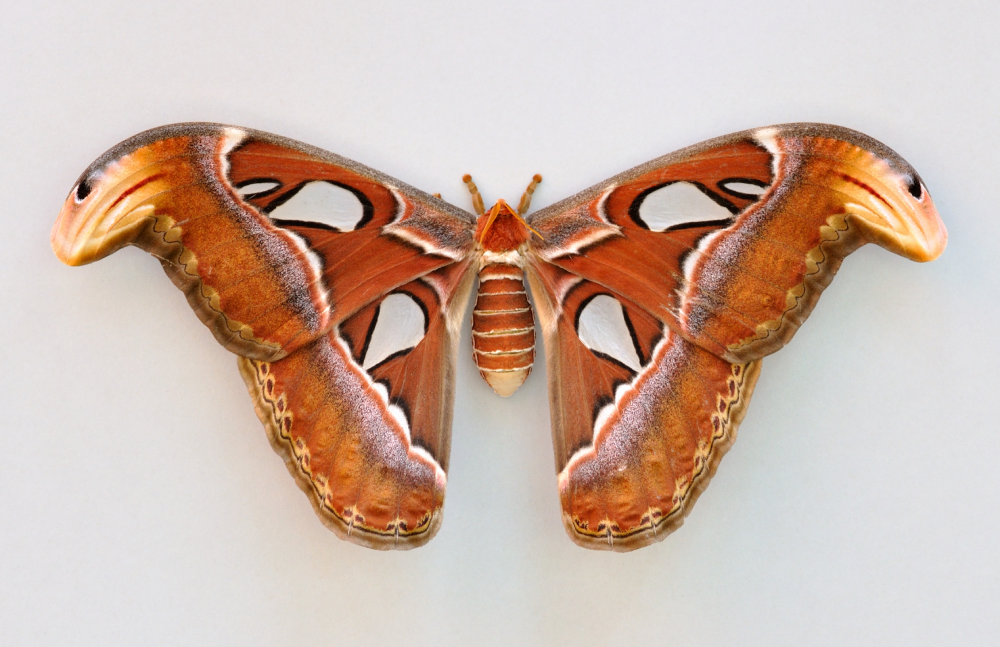In the twilight realms of the tropical forests of Southeast Asia, a majestic creature silently glides through the night, its wingspan vast and its presence awe-inspiring. This is the Atlas Moth (Attacus atlas), a species renowned for its immense size, ethereal beauty, and fascinating life cycle. Named after the Greek Titan Atlas, who bore the weight of the heavens on his shoulders, the Atlas Moth embodies a sense of mythical grandeur that captivates all who encounter it.
Majestic Magnificence
The Atlas Moth is one of the largest moths in the world, boasting a wingspan that can reach up to 30 centimeters (12 inches) or more. Its wings, resembling intricately patterned tapestries, showcase a mesmerizing blend of earthy tones, ranging from shades of rusty browns and oranges to soft, subtle greens. These colors, along with delicate patterns that mimic foliage, serve as camouflage, allowing the moth to seamlessly blend into its forested habitat.
Despite its imposing size, the Atlas Moth is a creature of grace and delicacy. Its flight, though gentle and slow, is a sight to behold as it glides effortlessly through the air, its wings fluttering with a serene elegance. Such grace belies the moth’s short lifespan, which typically lasts only a few weeks, during which its primary focus is reproduction.

The Circle of Life
The life cycle of the Atlas Moth is a testament to the intricate interconnectedness of nature. It begins when a female moth lays her eggs on the leaves of its primary host plants, including species such as the cassava, citrus, and cinnamon. These eggs, small and spherical, soon hatch into voracious caterpillars that voraciously feed on the leaves of their host plants, consuming vast quantities of vegetation as they grow.
As the caterpillars mature, they undergo several molts, shedding their exoskeletons to accommodate their increasing size. During their final instar, the caterpillars cease feeding and embark on a remarkable transformation. They seek out a suitable location, often high in the canopy, where they spin a silken cocoon around themselves, encasing their bodies in a protective shroud.
Within this cocoon, the caterpillar undergoes a miraculous metamorphosis, gradually transforming into a pupa as its body undergoes profound changes. After several weeks of this dormant state, the pupa emerges as a fully-formed adult moth, its wings unfurling to reveal the resplendent beauty of the Atlas Moth in all its glory.
A Symbol of Transformation
The Atlas Moth holds deep symbolic significance across various cultures, representing themes of transformation, renewal, and spiritual awakening. In many traditions, the moth’s emergence from its cocoon is seen as a metaphor for personal growth and enlightenment, symbolizing the journey of self-discovery and inner transformation.
Furthermore, the Atlas Moth serves as a poignant reminder of the delicate balance of ecosystems and the importance of conservation efforts to preserve biodiversity. As habitat destruction and climate change threaten the delicate ecosystems that support these magnificent creatures, the Atlas Moth stands as a sentinel, urging us to heed the call of stewardship and protect the natural world for generations to come.
Conservation Concerns
Despite its cultural significance and ecological importance, the Atlas Moth faces numerous threats to its survival. Deforestation, driven by logging, agriculture, and urbanization, has resulted in the loss of vast swathes of its habitat, fragmenting populations and reducing available resources. Additionally, pollution, climate change, and pesticide use further exacerbate these challenges, placing additional pressure on already vulnerable populations.
To safeguard the future of the Atlas Moth and other species dependent on tropical forests, concerted conservation efforts are essential. These efforts may include habitat restoration initiatives, sustainable land management practices, community-based conservation projects, and raising awareness about the importance of biodiversity conservation.
Conclusion
In the heart of the dense tropical forests of Southeast Asia, the Atlas Moth reigns as a majestic emblem of nature’s grandeur. Its colossal wingspan and ethereal beauty inspire wonder and admiration, while its remarkable life cycle embodies themes of transformation and renewal. Yet, beneath its enchanting facade lies a creature vulnerable to the threats of habitat loss, climate change, and human activity.
As custodians of the natural world, it is our collective responsibility to protect and preserve the habitats that sustain these magnificent creatures. So, by embracing the principles of conservation and fostering a deeper appreciation for the intricate web of life, we can ensure that the Atlas Moth continues to grace the night skies for generations to come, a timeless symbol of nature’s resilience and splendor.









